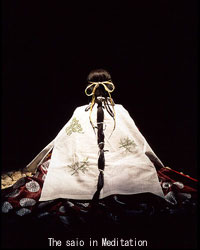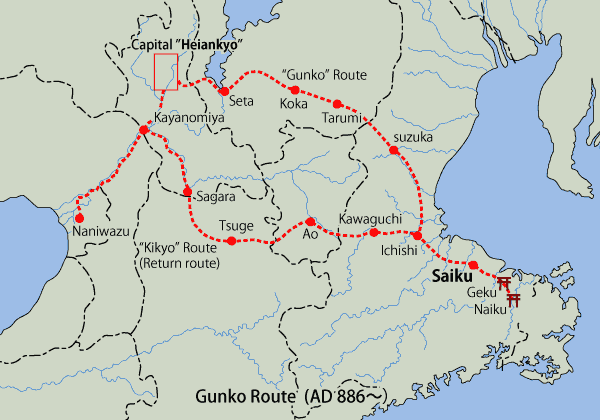What is Saiku ?
 The Chinese characters for "Saiku", are also read "Itsukinomiya".
The Chinese characters for "Saiku", are also read "Itsukinomiya".
This countryside, which has an unusually elegant name, was once the dwelling place of the Saio, who served the Great God of Ise.
Saiku refers to the palace of the Saio,who was also referred to as "Itsuki-no-himemiko" and appointed by each acceding Emperor to serve at the Grand Shrine of Ise (Ise Jingu),and her servants′public offices.
The Saio,selected from amongst the unmarried Imperial princesses and appointed through fortune-telling,would undergo purification rites with her court for a period of 3 years before embarking on the journey to Saiku.During the Heian period,this journey,called "gunko" (mass procession),proceeded initially from the town of Oumi through the mountain range of Suzuka before ending in the land of Ise,lasting 6 days and 5 nights.
The Saio System,established in the latter half of the 7th century by Emperor Tenmu,lasting for roughly 660 years.After Saiku reached the heights of its prosperity in the lOth and 11th centuries,it disappeared during the disturbance of the Nanbokucho period around the mid-14th century.
A great number of buildings with thatched roofs made from the bark of Japanese cypress,cogon,and shingle,erected with pillars dug into the ground at Saiku.It is at this place that under the administration of the Saiku Chief Cabinet,male officials and court ladies including the nurse and other ladies-in-Waiting numbering up to several hundred people served the Saio.

Although the Saio's principal duty was to serveat Ise Jingu,She actually only visited the Grand Shrine of Ise 3 times a year for the Tukinamisai in June and December and the Kannamesai in September.Aside from those times,it is said that she lived a modest day-to-day life.However,the existence of holy Saios in service to the gods who lived a refined life that mirrored the lifestyle of the capital city are mentioned in numerous pieces of ancient literature,such as the "Ise Monogatari", and the "Yamato Monogatari", conveying an image of elegance.
